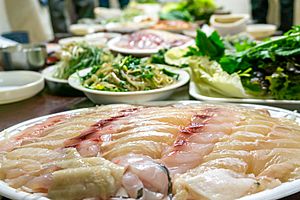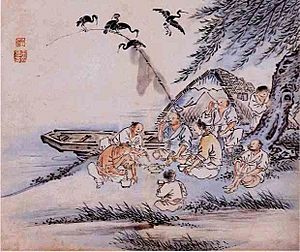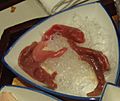Hoe (food) facts for kids
 |
|
| Alternative names | Hwe |
|---|---|
| Type | Raw fish |
| Place of origin | Korea |
| Associated national cuisine | Korean cuisine |
| Variations |
|
| Korean name | |
| Hangul |
회
|
|---|---|
| Hanja |
膾; 鱠
|
| Revised Romanization | hoe |
| McCune–Reischauer | hoe |
| IPA | [ɸwe̞] |
Hoe (Hangul: 회; Hanja: 膾/鱠 pronounced [hwe]) refers to several varieties of raw food dishes in Korean cuisine, consumed with local diversity by Koreans of all classes since the Three Kingdoms of Korea (57 BC - 668 AD), or earlier.
Varieties
There are uncooked hoe (회) as well as blanched sukhoe (숙회).
Raw
Hoe (회), the raw fish or meat dish, can be divided into saengseon-hoe (생선회), filleted raw fish, and yukhoe (육회), sliced raw meat. Saengseon-hoe (생선회) can be either hwareo-hoe (활어회) made from freshly killed fish, or seoneo-hoe (선어회) made using aged fish. Mulhoe (물회) is a cold raw fish soup.
- Baemjangeo-hoe (뱀장어회) – freshwater eel
- Baendaengi-hoe (밴댕이회) – sardinella
- Bangeo-hoe (방어회) – amberjack
- Bungeo-hoe (붕어회) – Crucian carp
- Daegu-hoe (대구회) – cod
- Dorumuk-hoe (도루묵회) – sandfish
- Gaebul-hoe (개불회) - fat innkeeper worm
- Gajami-hoe (가자미회) – righteye flounder
- Gamulchi-hoe (가물치회) – snakehead
- Gehoe (게회) – crab
- Gul-hoe (굴회) – oyster
- Gwangeo-hoe (광어회) – olive flounder
- Haesam-hoe (해삼회) – sea cucumber
- Hongeo-hoe (홍어회) – skate
- Ingeo-hoe (잉어회) – carp
- Jari-hoe (자리회) – chromis
- Jogae-hoe (조개회) – clam
- Jogi-hoe (조기회) – yellow croaker
- Junchi-hoe (준치회) – ilisha
- Mineo-hoe (민어회) – brown croaker
- Muneo-hoe (문어회) – giant octopus
- Myeongtae-hoe (명태회) – pollock
- Nakji-hoe (낙지회) – long arm octopus
- Nongeo-hoe (농어회) – seabass
- Saengbok-hoe (생복회) – abalone
- San-nakji (산낙지) – long arm octopus
- Ssogari-hoe (쏘가리회) – mandarin fish
- Sungeo-hoe (숭어회) – mullet
- Munggae-hoe (멍게회) - sea pineapple
- Jeoneo-hoe (전어회) - konosirus
- Ureok-hoe (우럭회) - refers to korean rockfish and Sebastes hubbsi
- Galchi-hoe (갈치회) - largehead hairtail
Blanched
Sukhoe (숙회) is a blanched fish, seafood, meat, or vegetable dish. Ganghoe (강회) is a dish of rolled and tied ribbons made with blanched vegetables such as water dropworts and scallions.
Preparation
Hwareo-hoe (활어회) is prepared by filleting freshly killed fish, while seoneo-hoe (선어회) is made with aged fish in a similar way as Japanese sashimi: removing the blood and innards and ageing the fish at a certain temperature before filleting. Fish or seafood hoe is often served with gochujang-based dipping sauces, such as cho-gochujang (chili paste mixed with vinegar) and ssamjang (chili paste mixed with soybean paste). Hoe is often eaten wrapped in ssam (wrap) vegetables, such as lettuce and perilla leaves. After eating hoe at a restaurant, maeun-tang (spicy fish stew) made with the bones, head, and the remaining meat of the fish, can be served as an add-on dish.
History
With the popularization of Buddhism in Korea, beginning in the middle of the Three Kingdoms period, and running late into the Goryeo Dynasty (918–1392), the consumption of fish and other meat products (including hoe) declined. As the influence of Buddhism waned in the late Goryeo Dynasty period, the consumption of hoe began to lose its stigma.
During the Joseon Dynasty, the state promoted Confucianism, and, as Confucius was known to have enjoyed eating raw meat, hoe consumption greatly increased.
Gallery
-
Bangeo-hoe (raw amberjack)
-
Gaebul-hoe (raw fat innkeeper worm)
-
Godeungeo-hoe (raw chub mackerel)
-
Galchi-hoe (raw largehead hairtail)
-
Muneo-hoe (raw giant octopus)
-
Ojingeo-hoe (raw flying squid)
-
Jeonbok-mulhoe (cold raw abalone soup)
-
Hoe-naengmyeon (cold noodles with hoe)
-
Hoe-deopbap (bibimbap with hoe)
See also
 In Spanish: Hoe para niños
In Spanish: Hoe para niños
















